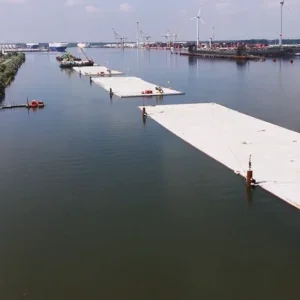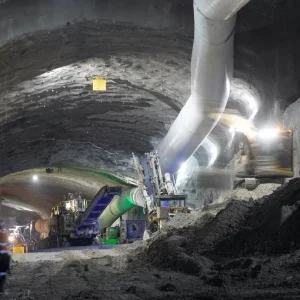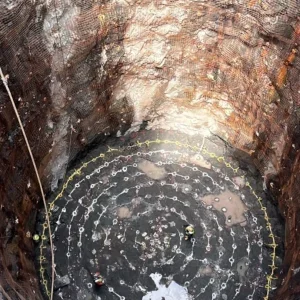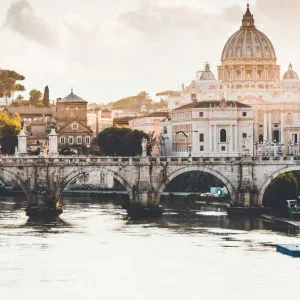Pietro Lunardi founded Rocksoil in 1979 to provide design, consultancy and technical assistance for civil engineering projects. His son, Giuseppe Lunardi, is Rocksoil CEO and managing director. He explains the setup of the company.
“Rocksoil Engineering is the holding company of the group which has two subsidiaries, Rocksoil and Tre Esse Engineering,” Giuseppe says. “Tre Esse offers onsite geotechnical and structural monitoring. We also have a 65 per cent stake in the Earth System company, which designs and manufactures the equipment, data loggers and software for geotechnical, environmental and structural monitoring. They typically combine for contracts, but Tre Esse and Earth System can also work on behalf of a third party.”
Among the company’s latest projects is the new highway connecting Bologna with Florence. This work is included in the Variante di Valico project, which is led by Autostrade per l’Italia.
The company has also designed several Italian metros such as Brescia, Milan (Linea 4 and 5 and parts of Linea 3), Genoa, Rome B1-C and Naples. “The majority of these works are carried out by integrated contracts so we work as contractors’ designers,” Giuseppe says, adding there is continuous demand for this kind of work. “Even if many cities have already built underground facilities, they need to update their network.”
Some of our ongoing projects further afield from Italy include: the Cityringen in Denmark, the Al Diwani metro station in Qatar, the Riyadh metro project in Saudi Arabia and the D1 highway in Slovakia.
Foreign Hopes
The company is targeting foreign markets and is tendering for underground contracts in Brazil. “I think the South American market may be relevant for the tunnelling sector because of the need to invest in infrastructure in that area.” Giuseppe adds, “Iran is another important market, which, thanks to its extensive mountainous area, requires a lot of infrastructure for metropolitan, railway and road projects. “We have also had success in Russia for the Sochi 2014 Olympics. We drew up the construction project for Sochi bypass and provided the technical assistance on site during construction.”
Among the tunnels built for the bypass, galleries T8 and T8A were quite challenging due to the extreme geological conditions. Thus, works had to be performed at the length of the track underground (1.55km for the tunnel T8 and 1.523km for the tunnel T8A) and to the size of the excavation sections, which vary from 120 sqm to 220 sqm. The cover on the tunnel cap reaches 75m in the northern sector, but it is low on the average and within a heavily urbanised environment.
“Unfortunately, Russia has been affected by a strong recession and the depreciation in commodities has slowed down many projects. However, the market is showing some slight signs of recovery,” Giuseppe says.
“The US market is making a comeback in the tunnelling sector because they understand the value of utility investment. Even if North America doesn’t need as many tunnels as Europe, there could be the impetus to invest in underground projects due to the expansion of urban areas. It’s also well-known that Americans use old-fashioned tunnelling techniques so we think it could be a good opportunity to show off our expertise.”
However, Rocksoil’s strongest market is northern Europe, including Scandinavia, Germany and France.
Regarding the Italian market, Giuseppe says there has been a contraction over recent years. “We are now completing works which started 10 years ago, but previous governments didn’t plan any infrastructure work. Despite this, we have started to see a slight increase of roughly 20 per cent in investments for the tunnelling sector.
“We are also waiting for European Commission approval for some corridors between Italy and Europe such as Turin-Lyon and Brenner.”
There will be also new lines related to a high-speed project to connect each part of Italy. “The AV/AC Line is ongoing to link Naples and Bari in the south of Italy,” Giuseppe explains.
“Another project is the Messina Strait bridge in Sicily, which will boost southern Italy’s economy.
“Rocksoil would not be involved in the suspension bridge design, but we would design the tunnel system, including both road and railway networks to ensure access onto both sides of the bridge.
“As there is seismic risk in that area, the suspension bridge has been designed, based on calculations, models and tests on a small scale, to withstand potential earthquakes,” Giuseppe says. “The ‘elastic’ structure can support every kind of seismic event. An excellent example of an earthquake-resistant bridge is the Akashi-Kaikyo in Japan, which is the longest suspension bridge in the world with a span of 1.99km. The Messina Strait should be 3.3km long with towers of 382.6m height, which should be taller than Akashi-Kaikyo’s towers of 297.3m height.”
Italian prime minister Matteo Renzi has revived plans for this bridge, saying the roadway across the Strait of Messina would be economically beneficial for the country. The total cost would be roughly EUR 9bn (USD 9.34bn).
World Tunnel Congress 2019
Giuseppe is vice-president of Italian Tunnelling and a member of the International Tunnelling Association (ITA) and is looking forward to his homeland getting to host the World Tunnel Congress in 2019.
“I think that WTC 2019 in Naples will be a good opportunity for Italy to show its resources to the rest of the world,” he says. “Our main competitors were big cities like London, Istanbul and Salzburg.
We worked hard to introduce our candidature to the 78 national members of the ITA and we are proud of being successful. This congress will be important to make our politicians understand the value of underground space. As a result, they should invest much more in underground facilities to get economical and environmental returns.”
Q & A with Pietro Lunardi
The leader of Rocksoil, and father of Giuseppe Lunardi, is a respected and experienced figure within the tunnelling industry. Here the former Italian cabinet politician shares career highlights and current thoughts.
When and why did you decide to become an engineer?
The decision to pursue my studies in civil engineering was due to my innate vocation for the natural world. Designing civic works allows you to protect the natural balance of the earth’s crust. My reference points are natural balances, which constantly drive all of my professional choices.
After being involved in politics as a Member of Parliament and Senat or for many years, what ca used you to return to engineering?
I strongly believe that I can serve my country much better as a designer of underground works than as an MP.
What has been the highlight of your career?
Always respecting nature allowed me to achieve great results and successes during my career. This is for me the biggest achievement.
How has the tunnelling industry changed throughout your career? What has changed for the better, and has anything become worse?
The tunnelling industry has changed markedly over the last 30 years. Big improvements include not just mechanised excavation methods, but primarily the project approach, which aims to plan everything in advance before starting underground works. This kind of approach ensures safe working and avoids money and time being wasted in the construction works.
What is becoming worse is the attitude of some tunnelling designers, who are not always able to keep up with the latest innovations.
Which project would you say has been a highlight for you?
I would mention two: the underground railway in the central areas of Milan, Viale Regina Giovanna, and the high-speed railway, which connects Bologna to Florence.
The first is a 260m-long stretch of rail, which is part of the Passante railway in the East-West side of Milan. The width of excavation is 30m with a maximum cover of 4m. The tunnelling works were carried out under ancient buildings along alluvial and unstable lands located under the aquifer level.
We opted for a bored tunnel to avoid any disruption and impact on road traffic and managed to achieve superficial settlements of 14mm.
The Bologna-Florence railway included the realisation of 104km of tunnels on a 78km route. This railway consists of a double-track tunnel with a width of 12.8m and it was excavated by traditional methods.
Following the Analysis of Controlled Deformation in Rocks and Soils (ADECO-RS) approach, we were able to avoid every kind of problem. Work took place between 1997 and 2005 and was completed on time despite poor geological, geomechanical and tectonic conditions.
Do you expect to see tunnelling used in any other new settings?
The tunnelling sector needs to achieve further improvements. Of course, carrying out big projects can lead us to develop new technologies. Nowadays the demand is closely related to the safety of tunnelling workers and optimisation. Optimising a project is the best solution to save money and time in construction and maintenance. Thus, I think that these topics will drive engineers to improve their projects in the near future.
What are your thoughts on the strength of the Italian tunnelling market?
As tunnelling experts we developed new technologies, which allowed us to work with unstable lands. So far we’ve managed to excavate even in the hardest stress-strain conditions. We always advance in full-face and ensure as much safety as there is when working in good rock conditions.
Do you think that state of the Italian economy is a threat to tunnelling?
The economic growth of countries depends on the quality of the public transport network. That means the need to plan this network in the short and long-term. Even if Italy has been affected by a strong recession, we are still seeing opportunities for infrastructure investments and, as a result, for tunnelling.
Where do you see tunnelling work coming from in the future?
Land use for building construction and infrastructure is reaching a dangerous level for the environment, especially in industrialised countries. In Italy 6 to 7sqm of land are used up every second.
This is clearly unsustainable and so we will increasingly be forced to consider underground, in which can offer huge spaces, as the ‘fourth dimension’. In that way, we can avoid a lot of problems related to the quality of life above ground, and ensuring the safeguarding of the environment as well.
Placing power and nuclear plants underground could reduce or even completely solve any environmental issues related to this kind of infrastructure, which nobody would like to have near their homes. The underground solution can also be applied to store energy from other sources like water or solar, and for disposal of hazardous waste at a depth of more than 200m.
I have been working on this project with Carlo Rubbia, an Italian particle physicist and inventor who shared the Nobel Prize in Physics in 1984 with Simon van der Meer for work leading to the discovery of the W and Z particles at CERN.
After carrying out an accurate cost-benefit analysis, we realised underground power plants are a valid alternative to those placed above ground.
Costs can be halved for both installation and decommissioning of the power plants. There won’t be any risks of radioactive emissions into the atmosphere as happened in Ukraine and Japan. For example, underground spaces beneath mountains could not be affected by this type of emissions because radioactivity doesn’t reach such depth, changing the route of neutrinos and other infinitesimal particles. Regarding earthquake issues, utilities placed underground transmit seismic waves without being damaged.
I’m sure this can be the future for tunnelling workers. Carlo and I will be studying and researching to realise our project.
Even Andrei Sakharov – the Russian nuclear physicist and activist for peace and human rights – said the future for safe energy should be projected towards underground nuclear plants.
Of course, the strong lobbyists for above ground power plants don’t like this project, but we keep going with our plans. We are going to propose our project to Armenia, which will need to redevelop the reactor in Metsamor, which is in a seismic area.
We can show them that they can save money and time by placing a new power plant underground.
How much of the tunnelling work is renovation/repair, compared to new projects?
First of all, underground works require much less maintenance than those built above ground. With renovation it’s necessary to update signage and lighting to modern standards in addition to building up new works from those existing. An example is the Variante di Valico highway A1, which connects Bologna to Florence.
Other opportunities for the renovation sector come from the “Nazzano method” for widening roads, motorways, main lines and metro rail tunnels without interrupting road and railway traffic. I developed this method to widen the Nazzano twin bore tunnel from two to four lanes in each direction. The 337m-long tunnel is located on the Milan-Rome A1 motorway.
The Nazzano method can be used to widen the old Montedomini tunnel on the A14 highway towards Senigallia. Wherever confined spaces prevent carrying out any variations to the existing works, we can adopt this method.
What are the challenges facing your company at the moment?
We need to spread the technologies developed over the last 30 years all over the world, showing the benefits in terms of costs and time saved by applying the correct tunnelling methods. I had the opportunity to talk about that during the Muir Wood Lecture at World Tunnel Congress 2015 in Dubrovnik.
What is your vision for your company? What are your plans for the future?
I’d like Rocksoil to keep on accepting new challenges in the future. This spirit led us to design many important projects in addition to offering technical assistance in ongoing works.
So far we have done that for a total of 1,200km of tunnels, of which 800km have been excavated with the traditional method and 400km with the mechanised method. The majority of these works have been designed and carried out in Italy, but we have also started working abroad over the last few years. Foreign markets appreciate our knowledge and experience in tunnelling, especially our ADECO-RS approach.







